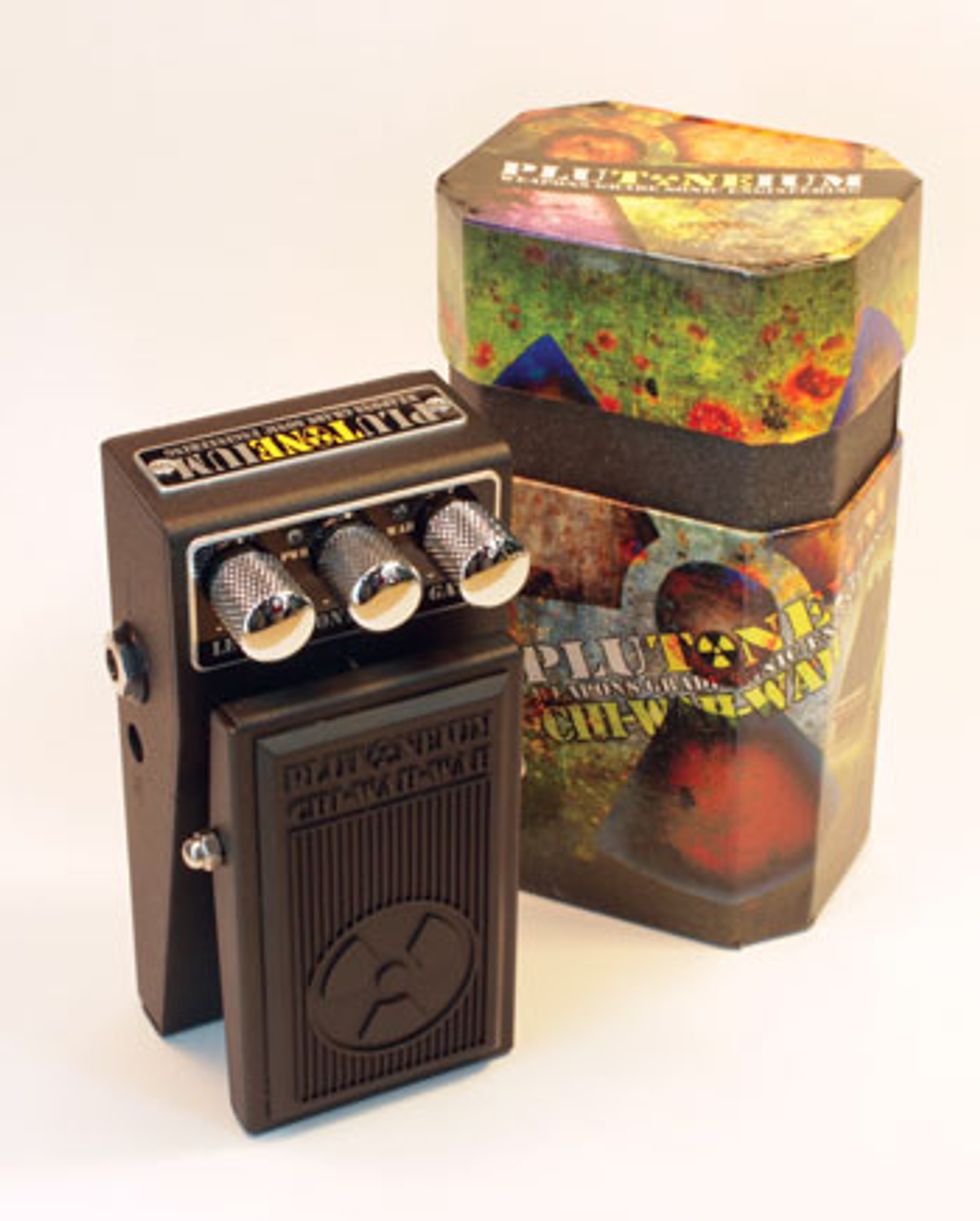The Chi- Wah-Wah is a very tiny breed of wah pedal—about the same size as a standard Boss pedal

The Plutoneium Chi-Wah-Wah uses a pressure-activated treadle to control wah sweep and speed.
According to effectsdatabase.com (a very informative and thoroughly researched website that I highly recommend visiting), more than 300 new brands of effects pedals and more than 2,000 individual effects devices were brought to market in 2011. With more than 300 new models and close to 40 new brands appearing on the radar in the first seven weeks of this new year, this deluge of stompers shows no sign of slowing down.
Despite this jaw-droppingly large amount of releases, one vital component appears to be lacking amongst the vast majority of new arrivals: innovation. It seems that many brands are playing it safe, sticking with subtle variations on tried-and-true concepts, rather than making any possibly risky moves that might take them away from the general direction of the flock.
Yet every so often a daring maverick grabs the wheel and steers the industry in a decidedly forward—if not slightly off-center—direction. One such innovator is a small company called Plutoneium (complete with intentional “tone” misspelling) and their unique brand of “weapons-grade sonic engineering.” This slogan is fully realized in their flagship product, the Chi-Wah-Wah.
As we all know, a Chihuahua is a very tiny breed of dog. Likewise, the Chi- Wah-Wah is a very tiny breed of wah pedal—about the same size as a standard Boss pedal, to be exact. But as the double-entendre name suggests, there’s a lot of energy packed into this tiny beast, and its bark and bite belie its diminutive nature.
Despite its compact design, every single aspect of the Chi-Wah-Wah screams quality. Plutoneium deserves to be commended for their “spare no expense” approach to manufacturing—a lot of larger and betterknown brands could learn from this. For example, the CWW’s casing is made from 1.5 mm rolled steel and features a tough powder-coated finish. The bottom plate is attached by four sturdy Allen screws, the nameplate is riveted to the casing, and jack labels are actually etched into the chassis. Top-mounted controls allow the user to tweak the effect on the fly (we’ll discuss this concept in a future column) and knurled metal knobs with set screws sit atop metal pot shafts. Bulletproof.
However, the unique aspect of the CWW lies not in its construction, but rather its ergonomics. Unlike a traditional wah pedal where the bass frequencies sit at the heel position of the treadle and treble at the toe, the CWW is set up in a reverse fashion with bass at the top position of its tiny treadle.
While at first this may seem counterintuitive, the genius of this design becomes evident when you consider that the CWW’s wah effect is automatically activated by simply pressing down on the treadle. As soon as your foot applies pressure to the treadle (its tension is adjustable), the wah effect engages and, starting in the lower frequencies, moves through the mid- and upper-frequencies as more foot pressure is applied.
Plutoneium refers to this feature as “wah-on-demand.” While it may sound strange or even sacrilegious to the wah purist, it’s actually much easier than having to step down hard on a wah treadle to engage (or not engage—oops!) the switch, then rock your heel back to grab the bass frequencies first.
This design also makes for much faster and more precise control over the wah effect, since you are using your body weight— rather than the position of your ankle—to control the treadle sweep. While it does take some getting used to, the CWW’s new way to wah can actually be far more expressive than the traditional wah design.
Of course, a pedal’s ergonomics rarely take a front-seat to sound quality, but once again the CWW has this aspect of wah design covered in spades. The CWW’s inductor-based circuit can be adjusted by the level, contour, and gain knobs mentioned earlier to give the user a wide palette of wah textures, ranging from smooth and mellow to sharp, loud, and obnoxious.
When you’re done making the CWW squawk, simply take your foot off of the treadle. The pedal features a short time delay where the wah stays active before disengaging the effect using a buffered, optical switching circuit. Dual LEDs indicate power and effect respectively, making it easy to tell the CWW’s current status at a glance.
Praises aside, there are a couple of aspects of the CWW’s operation that may bother some users. Since the treadle is spring-loaded it can’t be set in a “halfcocked” position, meaning no Michael Schenker imitations. In addition, the bypass delay does take some getting used to and can be somewhat awkward if you need to move between effected and clean sounds very quickly. However, based on the CWW’s ingenious operation, bulletproof construction, exceptional sound quality, and ultra-compact design of this pedal, I believe Plutoneium has successfully raised the bar of wah design and I suggest other manufacturers take note.
 Kevin Bolembach
is the president
and founder of Godlyke, the U.S.
distributor for many well-known
boutique effect brands, including
Maxon, Guyatone, EMMA, and
Providence..
Kevin Bolembach
is the president
and founder of Godlyke, the U.S.
distributor for many well-known
boutique effect brands, including
Maxon, Guyatone, EMMA, and
Providence..